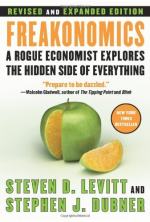
|
| Name: _________________________ | Period: ___________________ |
This test consists of 15 multiple choice questions and 5 short answer questions.
Multiple Choice Questions
1. According to child-mortality statistics, what is ten times more dangerous than a gun?
(a) A plastic bag.
(b) A television set.
(c) A swimming pool.
(d) A squirt gun.
2. In a per-hour study of likelihood of dying in a plane versus a car crash, how do they compare?
(a) There is no way to figure this.
(b) You are more likely to die in a car.
(c) You are more likely to die in a plane.
(d) You are just as likely to die in either a plane or car.
3. Who does Levitt point out has a nearly quadrupled likelihood of dying every year than a death row inmate has of being executed?
(a) A Black Gangster Disciple Nation soldier.
(b) A black child in 1960.
(c) A young man in Liberia.
(d) An American serviceman in Iraq.
4. What class range does the Early Childhood Longitudinal Study cover?
(a) Third grade through freshman year of high school.
(b) Kindergarten through fifth grade.
(c) First through eighth grade.
(d) Pre-K through third grade.
5. What final factor do the authors say affects the way a child develops?
(a) Random fate.
(b) Drugs.
(c) God.
(d) Peer pressure.
6. What does the ECLS show about the black-white achievement gap for students just entering school?
(a) It is nearly nonexistent.
(b) It has not changed since 1964.
(c) It is slowly narrowing.
(d) It is larger than expected.
7. In what year did the drop in New York violent crime begin in the 1990s?
(a) 1996.
(b) 1990.
(c) 1994.
(d) 1992.
8. What is the number one white girl name that indicates low education in a parent?
(a) Tonya.
(b) Angel.
(c) Mercedes.
(d) Tabatha.
9. How many names from the top ten most popular black boy's names from 1990 do not appear on the 2000 list?
(a) 7.
(b) 0.
(c) 1.
(d) 4.
10. Why did pro-gun advocate John R. Lott create a female pseudonym?
(a) To solicit sex online.
(b) To defend his theories.
(c) To have a tax credit for a dependant.
(d) To place on his own petitions.
11. How many American children per year would be saved if parents childproofed their pools?
(a) 30.
(b) 400.
(c) 175.
(d) 250.
12. According to child-rearing "expert" L. Emmett Holt, what is a baby's daily exercise?
(a) Breastfeeding.
(b) Rolling on the floor.
(c) Sleeping.
(d) Crying.
13. According to Peter Sandman, what is the defining attribute of irrational fears that we have?
(a) They all involve death.
(b) They are out of our control.
(c) They are covered regularly on TV.
(d) They have happened ot someone we know.
14. What was the well-publicized theory that informed the new policing strategies in New York in the Nineties?
(a) The community development theory.
(b) The borken window theory.
(c) The empowerment-disempowerment theory.
(d) The repeat offender theory.
15. Which figure in the book became a Harvard Fellow after doing field research in South Chicago?
(a) Ronald G. Fryer, Jr.
(b) Sudhir Venkatesh.
(c) Stephen Levitt.
(d) Arne Duncan.
Short Answer Questions
1. For what year are the authors attempting to forecast when they list possible future popular names at the end of the chapter?
2. What is the main reason that the price of crack cocaine began to drop in the Nineties?
3. Judith Rich Harris claims in her book, THE NURTURE ASSUMPTION, that parental influence is generally overwhelmed by what?
4. Which of the following factors is revealed not to have a correlative effect on a child's school performance?
5. How did the Chicago Public School system deal with the confusion of allowing students to choose any school in the city?
|
This section contains 608 words (approx. 3 pages at 300 words per page) |

|




